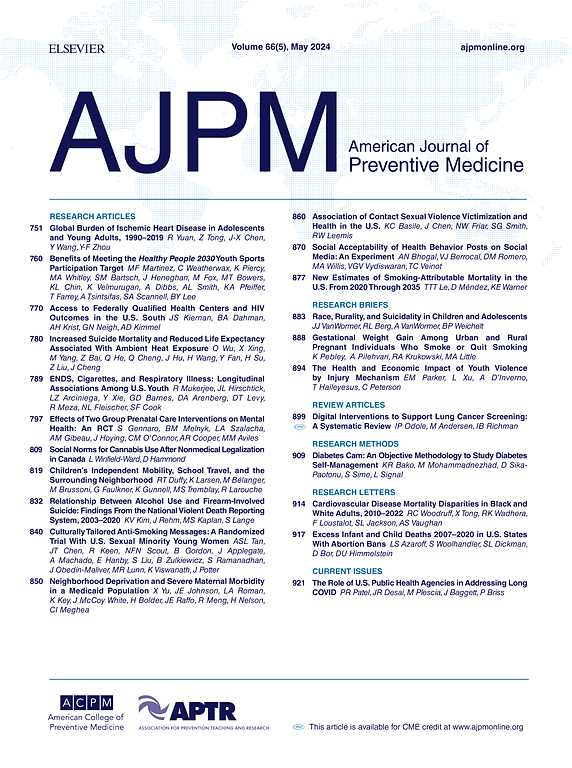院前约束和镇静的种族和民族差异。
IF 4.5
2区 医学
Q1 MEDICINE, GENERAL & INTERNAL
引用次数: 0
摘要
简介:紧急医疗服务(EMS)临床医生经常遇到经历行为健康紧急情况的患者,但有限的数据描述院前使用物理约束或镇静剂。系统性的种族主义和在获得行为保健方面的挑战可能导致少数群体在约束和镇静使用方面的差异。本研究考察了种族和民族是否与行为健康紧急情况患者院前使用身体约束和/或镇静有关。方法:使用2022年ESO数据协作,包括约12,000,000次紧急医疗服务(EMS)医疗保健遭遇,本研究估计了≥15岁因行为健康紧急情况遇到EMS的患者的种族和民族(非西班牙裔白人、黑人/非裔美国人、西班牙裔任何种族、亚洲人或美洲印第安人/阿拉斯加原住民)与身体约束和/或镇静使用(是,否)之间的关联。校正优势比(aOR)估计值为95%置信区间(ci)。结果:大约7.1% (n= 3799)的行为健康遭遇涉及任何约束或镇静使用。与非西班牙裔白人患者相比,所有种族和少数民族患者更有可能接受身体约束(aOR范围:1.62-2.72)。结论:约束和镇静使用的差异可能会使种族和少数民族患者,特别是黑人/非裔美国人患者在一个已经阻碍他们获得精神健康治疗的系统中长期存在不良的精神结局。本文章由计算机程序翻译,如有差异,请以英文原文为准。
Racial and Ethnic Disparities in Prehospital Restraint Use and Sedation
Introduction
Emergency medical service clinicians routinely encounter patients experiencing behavioral health emergencies, yet limited data describe the prehospital use of physical restraints or sedatives. Systemic racism and challenges in access to behavioral health care may contribute to disparities in restraint and sedation use among minoritized groups. This study examined whether race and ethnicity were associated with prehospital use of physical restraints and/or sedation among patients with behavioral health emergencies.
Methods
Using the 2022 ESO Data Collaborative consisting of ∼12,000,000 emergency medical service healthcare encounters, this study estimated the associations between race and ethnicity (non-Hispanic White, Black/African American, Hispanic any race, Asian, or American Indian/Alaskan Native) and physical restraint and/or sedation use (yes, no) among patients aged ≥15 years who had an emergency medical service encounter for a behavioral health emergency. AOR estimates with 95% CIs are presented.
Results
Approximately 7.1% (n=3,799) of behavioral health encounters involved any restraint or sedation use. All racial and ethnic minoritized groups were more likely to receive physical restraints (AOR range=1.62–2.72, p<0.05) than non-Hispanic White patients, whereas Black/African American, Hispanic, and American Indian/Alaskan Native patients were more likely to be sedated with antipsychotics or benzodiazepines (AOR range=1.27–3.21, p<0.05). Black/African American patients were also more likely than non-Hispanic White patients to be concurrently restrained and sedated (AOR=1.30, 95% CI=1.09, 1.55).
Conclusions
Disparities in restraint and sedation use may perpetuate poor psychiatric outcomes for racially and ethnically minoritized groups, particularly Black/African American patients, in a system that already hinders their access to mental health treatment.
求助全文
通过发布文献求助,成功后即可免费获取论文全文。
去求助
来源期刊

American Journal of Preventive Medicine
医学-公共卫生、环境卫生与职业卫生
CiteScore
8.60
自引率
1.80%
发文量
395
审稿时长
32 days
期刊介绍:
The American Journal of Preventive Medicine is the official journal of the American College of Preventive Medicine and the Association for Prevention Teaching and Research. It publishes articles in the areas of prevention research, teaching, practice and policy. Original research is published on interventions aimed at the prevention of chronic and acute disease and the promotion of individual and community health.
Of particular emphasis are papers that address the primary and secondary prevention of important clinical, behavioral and public health issues such as injury and violence, infectious disease, women''s health, smoking, sedentary behaviors and physical activity, nutrition, diabetes, obesity, and substance use disorders. Papers also address educational initiatives aimed at improving the ability of health professionals to provide effective clinical prevention and public health services. Papers on health services research pertinent to prevention and public health are also published. The journal also publishes official policy statements from the two co-sponsoring organizations, review articles, media reviews, and editorials. Finally, the journal periodically publishes supplements and special theme issues devoted to areas of current interest to the prevention community.
 求助内容:
求助内容: 应助结果提醒方式:
应助结果提醒方式:


